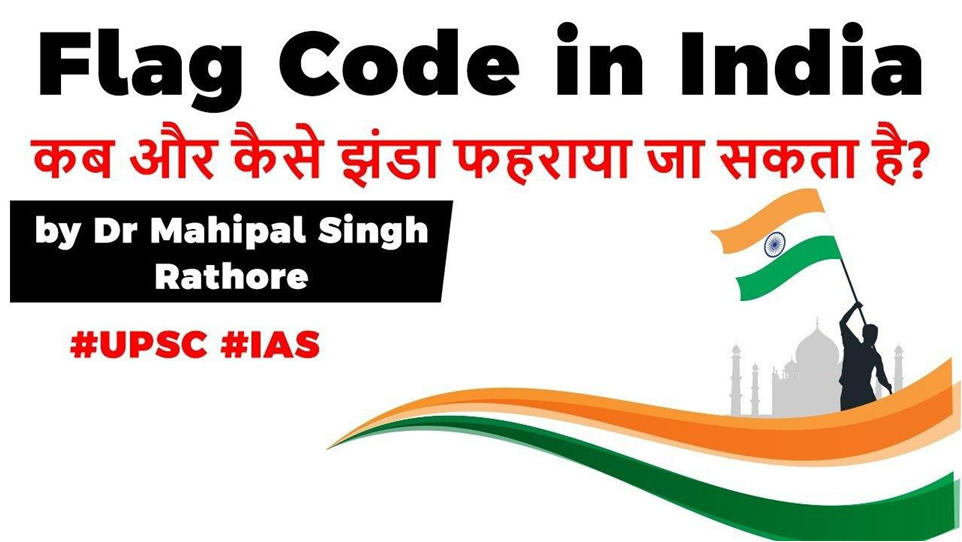Table of Contents
What is a Flag code?
- The Flag Code of India is a set of laws, practices and conventions that apply to the display of the national flag.
- It was codified in 2002.
- Earlier – THE PREVENTION OF INSULTS TO NATIONAL HONOUR ACT, 1971
Indian Tricolour
- The National Flag of India is a horizontal rectangular tricolour of India saffron, white and India green; with the Ashoka Chakra, a 24-spoke wheel, in navy blue at its centre.
- The flag is to be made of khadi or silk material only.
- The manufacturing process and specifications for the flag are laid out by the Bureau of Indian Standards

- It was adopted in its present form during a meeting of the Constituent Assembly held on 22 July 1947
Can Private citizens fly the national flag?
- Yes, They can.
- There is no restriction on the display of National Flag by members of the general public, private organizations, educational institutions, etc., provided they follow all the prescribed rules.
- That was not the case before 2002.
- Naveen Jindal, an industrialist/politician fought and won a case for the right to hoist the national flag by citizens.
- Where is the largest Indian flag hoisted?

The rules to be followed by Private citizens for hoisting the flag
- When the Flag is flown, it should occupy the position of honour.
- The Flag should be positioned with the saffron band on top and the green band at the bottom.
- The flag should be displayed in open and should be as far as possible, be flown from sunrise to sunset.
- No other flag should be placed higher than or above the National Flag.
- The flag shall not be intentionally allowed to touch the ground or trail in the water.
- The flag shall not be dipped in salute to any person or thing.
- Advertisement/Notification/Lettering of any kind should not be put upon the flag.
- The flag shall not be used for commercial purposes .
- When the Flag is displayed on a speaker’s platform, it should be flown on the speaker’s right as he faces the audience or flat against the wall, above and behind the speaker,

- Flag made of paper may be waved by public on occasions of important national, cultural and sports events.
- But paper flags should not be discarded or thrown on the ground after the event.
- A damaged or dirty flag should not be displayed.
- A damaged and soiled National Flag shall be destroyed in a private ceremony preferable burning or by any other dignified manner.

Use on Vehicles
- The privilege of flying the national flag on vehicles is restricted to
- President, Vice-President
- Chief Justice and Other Justice of Supreme court
- Prime Minister + Members of Council of ministers.
- Chief Minister of state + Members of Council of ministers
- Governors and Lieutenant Governors of states,
- Chief Justice and Justice of High court of States,
- LS Speaker, RS Deputy Chairman
- Speaker State Assembly, Deputy chairman of of state legislative council
- Ambassadors of India in foreign nations
- Flag officers of the Army, Navy and Air Force.


- When a foreign dignitary travels in a car provided by the government of India, our National Flag will be flown on the right side of the car and the flag of the foreign countries will be flown of the left side of the car
Prohibited usage
- The Flag shall not be used as a drapery in any form whatsoever except in State/Military/Central Para military Forces funerals.
- The Flag shall not be used or stored in such a manner as may damage or soil it.

- The Flag shall not be draped over the hood, top, sides or back of a vehicle, train or boat.

- What is the punishment for insulting the flag?
- As per Section 2 of ‘The Prevention of Insults to National Honour Act, 1971’
- ‘Whoever, in any public place or in any other place within public view, burns, mutilates, defaces, defiles, disfigures, destroys, tramples upon or otherwise shows disrespect to or brings into contempt (whether by words, either spoken or written, or by acts) the Indian National Flag or any part of it, shall be punished with imprisonment for a term which may extend to three years or with fine, or with both.,
Latest Burning Issues | Free PDF






















 WhatsApp
WhatsApp